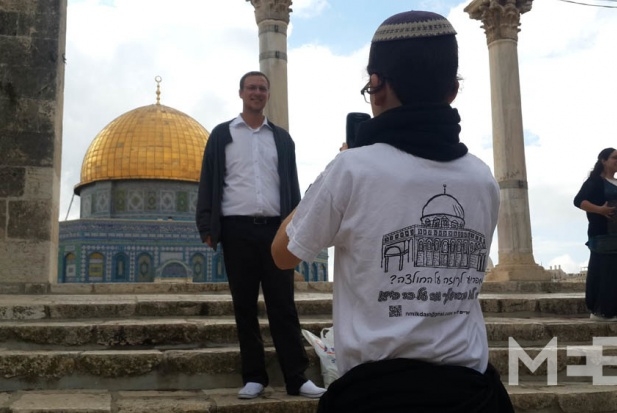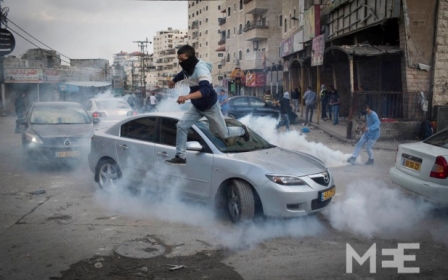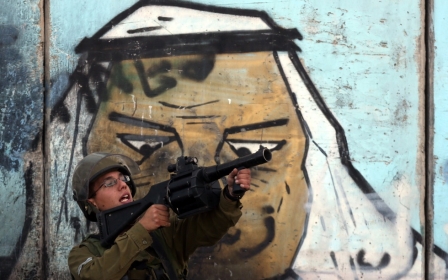A tense tour of Al-Aqsa with the Temple Mount movement

Israeli right-wing activists gathered at the Western Wall in Jerusalem's Old City on Wednesday with the intent of entering al-Aqsa compound through the Mugrabim bridge.
By 7:00 am local time (0500 GMT) more than ten police vans were already parked near the Western wall. After a few minutes, the right-wing activists started lining up in front of the small gate.
The activists had chosen to return to the site one week after right-wing activist Yehuda Glick was shot and seriously injured by a gunman on a motorcycle. Glick is best known for heading up the Temple Mount organisation that advocates building a Jewish temple on the grounds where al-Aqsa – the third most revered site in Islam – currently stands.
The following day, Israeli police shot and killed Mu'taz Hijazai, a Palestinian from East Jerusalem, who they said was the main suspect in Glick’s attack.
On weekdays, tourists and Jews can enter the compound between 7:30 am to 10:00 am and then again at 12:00 pm to 1:00 pm. Visitors are escorted by police and are not allowed to pray or preform any religious ceremony. Right-wing activists like Glick come to al-Aqsa almost every day although on some days the police close the compound to non-Muslims.
Tensions have grown in recent years as more right-wing Israelis try to enter and even pray on the site, even as restrictions on Muslim worship increase.
This Wednesday, however, was destined to be particularly turbulent.
Just before 8:00 am (0600 GMT) fireworks were ignited by Palestinians from inside the compound. Seconds later, a large police force stormed the compound.
Some 50 Palestinian youth clashed with Israeli police forces. Police fired rubber bullets into the crowd. At least one Palestinian youth was injured and was shot in the face.
While police pushed ahead, Jewish activists started to dance and sing. Chants of "we will rebuild the temple," in Hebrew could be heard above the clashes.
Guy, a young Israeli man at the scene, who did not want to give his last name said that these days he tries to enter al-Aqsa compound every day: "Sometimes the police give us permission to do only a small tour, and sometimes we can walk all around the Dome of the Rock."
Before long, the activists standing in the line waiting to enter, started getting reports that the compound has now been closed off for visitors.
Haggi Yekutiel, a close friend of Glick addressed the crowd: “We are going into the Temple Mount in order to pray, not as a tourist site, we are going there in order to build the Temple, and we are building the Third Temple in every prayer we recite in the Temple Mount."
Hillel Weiss, a well-known right-wing settler got up next. "Israel is the most anti-Semitic country in the world; this could not happen in any other country in the world, and because of that, we should not obey these laws,” he told the group as they continued to wait in line.
“We should not listen to the police. As Jews, we should break the gates to al-Aqsa and not stop in front of them."
By 8:20 am, as the group continued to wait in line as clashes continued inside the compound, people began to perform prayers for Glick’s recovery. He remains in in serious condition in a Jerusalem hospital.
Ten minutes later, the police announced that they had closed the compound. Haggi advised the crowd of activists to return in 30 minutes, but a few activists began getting agitated and said that they would keep waiting.
Within a few minutes, news broke that tourist groups were being allowed entry.
As a police helicopter flew overhead, a right-wing activist asked his friend, “How expensive is it to operate a helicopter for an hour?”
His friend replied: “Bullets are cheaper. That’s for sure.”
The first man quickly responded: “Bullets are priceless but it depends where you hit with them."
At 8:40 am, Israeli police allowed the right-wing activists, escorted by a few anti-riot police forces, to enter.
The rules were very clear: "No praying, no singing. Just walking in one group."
As the group crossed over Mugrabim bridge, they were greeted by another activist who praised them for visiting the Temple Mount, known as al-Aqsa to Muslims.
A member of the Waqf – the Palestinian-Jordanian group that administrates the mosque - joined the group to ensure that no one was praying. The activists seemed rattled by his presence.
One activist shouted at the policeman accompanying the group. "Don't listen to him, he is a Jordanian, he has no authority here,” he said.
The group then moved through and entered the compound that surrounds the Dome of the Rock, the iconic gold-domed mosque in al-Aqsa that is seen as the third most holy site in Islam that is in principle out of bounds to all non-Muslims.
Shmuel Ben Hamo, the group’s guide pointed to al-Aqsa mosque and said: "All the area around al-Aqsa Mosque is not part of the Temple Mount, this is why al-Aqsa is not bothering us, we have no interest in it, it will become a hall for celebrations after we build the Temple."
The compound was full of police, with only a few Muslims on site because of the earlier clashes. By that time most Palestinians had either been pushed out by police or had hidden inside The Dome of the Rock.
The groups’ knowledge of the compound was clear to see and many boasted of regularly visiting.
As the group stopped for a short rest, the guide addressed the political obstacles involved in rebuilding the Third Temple, which is prophesied in ancient religious Jewish texts.
"The Israeli secular public does not want the Temple, as if it is just a building. It's not a fancy synagogue, it's a regime,” Ben Hamo told the group.
When we rebuild the temple, “there will be no Supreme Court anymore. The Sanhedrin [the court system of the biblical times] will be the court. It's understandable, the seculars will lose their power, instead of the government there will be a king. It will change the entire regime.”
When asked how the tour groups attract attention and visitors, Ben Hamo explains that: “We don’t publish anything; no Facebook or email. We just speak among ourselves. Between 200 to 300 people arrived. But the big success is that the police decided to keep the Temple Mount open today despite the fact so many Jews came.”
According to Ben Hamo the police usually close the compound if there are a lot of Jewish visitors.
“They close the compound so people will get disappointed and will not go in, and also because of the fear that the other side [the Palestinians] are getting organised to make a mess."
The message seems clear.
“Our struggle for this country is here, this is the heart of the struggle,” he told MEE. “The moment the Arabs understand that … we want to build a Temple, we don't come here to tour, we want first of all to build an altar. And after we build it, all the Arabs will respect us, and will want to help us.”
But the dialogue quickly shifts to the wider battle that Ben Hamo believes the Temple Mount movement and its followers are trying to achieve.
“The struggle here is national and religious, between two nations, the Muslims against the Jews. When they will see we are waking up, they will accept it,” he said.
“Today many Israeli Parliament members come to visit here, and they even climb to the level of the Dome of the Rock, to show Israeli sovereignty here. The general public is healthy; in a poll a few years ago, 64 percent said that they believe the Temple will be rebuilt. We are here because of the Bible and no other reason.”
The tour in total lasts about 40 minutes, and while most of the group seemed happy to have visited, resentments remain.
"Our rights are still violated, because we are Jews and not tourists we have to wait longer in the line, and we are not allowed to pray,” said Guy, the young man who said he tried to come to al-Aqsa almost every day.
As the group, backed by its police escorts, left the Old City they were greeted by lines of Palestinians waiting outside, many of whom have not been allowed in since the morning. Some of the Palestinians began shouting, obviously riled up by seeing the right-wing activists being escorted out.
The police quickly start pushing them back, as some of the tour group began to snap photos with their mobiles.
The situation quickly escalated, with clashes spreading and police moving in to disperse the protesters with stun grenades.
A few hours later, a Palestinian man rammed his van into a group of people waiting at a tram stop. A policeman was killed and thirteen other people injured. It was the second such attack to rock East Jerusalem in two weeks.
Stay informed with MEE's newsletters
Sign up to get the latest alerts, insights and analysis, starting with Turkey Unpacked
Middle East Eye delivers independent and unrivalled coverage and analysis of the Middle East, North Africa and beyond. To learn more about republishing this content and the associated fees, please fill out this form. More about MEE can be found here.





